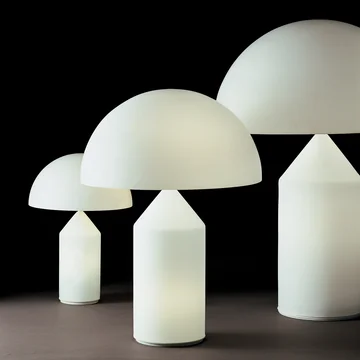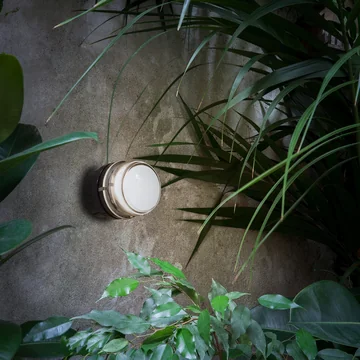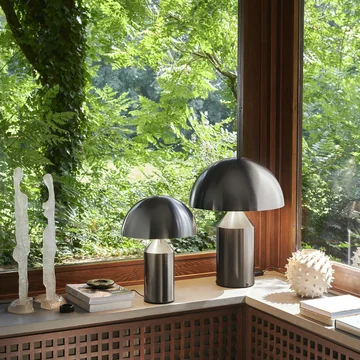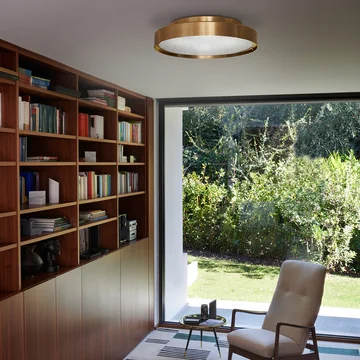Oluce was established in 1945 by Giuseppe Ostuni, making it the oldest italian lighting design company that is still active.
In fact, before the war there existed only Gino Sarfatti's Arteluce, which disappeared in the late '90s, while 1948 saw the birth of Azucena and Lamperti, followed by Arredoluce and Stilnovo in 1950. Many years it was chiefly Arteluce, Azucena and Oluce that dominated the Italian scene, creating a hub for the designers - strongly engaged first in the reconstruction and later in the birth of serial production - who animated the Milanese forum:
Vittoriano Viganò and BBPR, Gigi Caccia Dominioni and Ignazio Gardella, Marco Zanuso and Joe Colombo. As early as 1951, Oluce registered a success at the IX Triennale, in the lighting section directed by Achille, Livio and Pier Giacomo Castiglioni, with an indirect incandescent bulb designed by Franco Buzzi. In the following years there was the ground-breaking ''Agnoli'' model (255/387), a spot light supported on a slender stem, which in 1954 marked the decline of lampshades and the rise of highly simplified floor lamps, even for domestic lighting. In addition to Agnoli, Ostuni's collaborators included:
Forti, the forgotten advocate of a new living style for the Milanese high middle class, as well as Arnaboldi, Monti and Minale. But it was only at the end of the decade, thanks to the encounter with Joe and Gianni Colombo, that Oluce took a more pronounced revolutionary slant. The Colombo brothers (subsequently only Joe pursued his incisive sorties into the world of lighting objects, while Gianni devoted himself to the fine arts) were seeking a receptive environment for their audacious designs: this was Oluce. First there was the ''Acrilica'' table lamp (mod.
281), included in the Oluce catalogue as of 1962: a very thick Perspex curve through which the light appears to climb, exemplifying both a possible meeting point between art and design, as well as an elegant use of new materials. A gold medal winner at the XIII Triennale, where Joe Colombo also won two silver medals (for the ''Combi-Center'' and the ''Mini-Kitchen''), the ''Acrilica'' consolidated Joe Colombo as one of the great designers of the day. In the following years Colombo had already moved on, creating his ''Coupé'', a curved stem of considerable size supporting an elegant semi-cylindrical shade, now exhibited at the MoMA in New York.
It came out in 1972, one year after the premature death of Joe Colombo, and was therefore named ''Colombo'' in his honour.
The first indoor halogen light to appear on the market, it became an unsurpassed icon of a design that is both functional and contemporary.

After death of Colombo, a new era began for Oluce. This is partly because Giuseppe Ostuni passed on the company into the hands of the Verderi family. With this occurence, Vico Magistretti becomes the art director and chief designer of Oluce and will remain so for years.
Magistretti is considered to be one of the great masters of Italian design. Magistretti left a distinctive legacy at Oluce and shaped the company with his unmistakable style, which has found worldwide recognition. Kuta, Lester, Nara, Idomeneo, Pascal, Dim, Sonora, Snow, and especially Atollo - all became names that instantly called to mind the corresponding product.
Atollo even became a sort of template, a graphic silhouette that immediately rendered the concept of a ''lamp''. Since 1995, Oluce has taken a different tack under the art direction of Marco Romanelli, one which bolstered its international success and the collection's critical acclaim. The new formula put the focus on expressing highly diverse personal languages, in particular those of leading contemporary designers, such as the Englishman Sebastian Bergne, the Swiss Hans Peter Weidmann, and the Italians Laudani&Romanelli.
Website by Oluce




